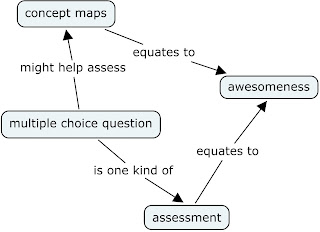So my personal genomics module was fun - it was a very small class of co-operative students who are used to asking and answering questions and doing the occasional activity. I'll write more on how it went once I've surfaced from the avalanche of work that has buried me for the last few weeks. In the meantime, I'm freaking out about the prospect of herding 250 students through some pretty complex activities.
My departmental FIRST IV Buddy (let's call him F1B) took the first class in a similarly-sized section last week, and of course did a fabulous job, including presenting the results of their natural selection pre-test (some questions from the CINS and the dinosaur question) as a introduction to the misconceptions we will be addressing. However, the difficulties of 'parachuting in' a totally new learning mode for two weeks in the middle of a semester became obvious. We can't create formal groups, and even if we could, we have no mechanism to introduce group accountability, because all the marks have to come from the exam or clicker questions. This also means that there is no grade incentive to actually engage in any of the activities, only the nebulous (to a stressed-out freshman) incentive of improved learning. And I believe in grade incentives; they're the currency of teaching and learning. We are assigning a value to the various pieces of work that students are asked to do, and the value we assign should reflect the importance of that work to achieving learning goals. If I think it's so important to engage in a learning activity, then a grade tells students I really mean it. At least, that's the way students talk about it (they're always complaining about unassessed work and 'optional' readings).
The obvious drawback to my opinion is that 250 bums-on-seats eventually means 250 scrawled short answers or cramped concept maps/mini-maps/box-and-arrow-diagrams. I know that Diane and some of our esteemed FIRST IV faculty use undergraduate teaching assistants to help with grading, but my university absolutely forbids us to do that. So, the solution I've come up with this morning, which I'll ask F1B about today, is to have some clicker question marks tied to activities. For instance, on Monday they'll be doing a Hardy-Weinberg equilibrium activity in which they'll have to do things like calculate allele frequencies and predict equilibrium genotype frequencies. To encourage participation, we could get them to 'click-in' one of their answers (from 5 choices). It seems lame, but otherwise I envisage one-half of the class bothering to join in and one-half not bothering.



